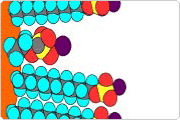Search
Specialty Latex Beads
 In addition to our popular super-active and high activity beads, Invitrogen offers several specialty latexes and crosslinked particles for specialized needs. Those listed below are some of our more popular specialty beads; please see our product listings or contact custom bead services for other possibilities.
In addition to our popular super-active and high activity beads, Invitrogen offers several specialty latexes and crosslinked particles for specialized needs. Those listed below are some of our more popular specialty beads; please see our product listings or contact custom bead services for other possibilities.
Divinyl Benzene Cross-Linked Particles
DVB/Carboxyl Type ID: 14 4% solids
DVB/Sulfate Type ID: 13 4% solids
This group contains polymer which is cross-linked to produce particles which are capable of dispersion in organic solvents such as benzene or toluene. However the particle will swell in these solvents and a portion of the un-crosslinked polymer chains may be lost. When dispersed in organic solvents, the particle size will be different from that reported by T.E.M. The surface functional groups are as active as those on the un-crosslinked spheres in aqueous conditions.
Sulfate (Suftactant Prep.)
Type ID: 16 now 10% solids
| These microspheres are made in a precisely controlled batch polymerization process which ensures reproducibility in both size and latex surface chemistry from batch to batch. Mixed-bed ion exchange cleanup prior to use is recommended for most applications. Physical adsorption of proteinaceous substances to the ultra-clean latexes is irreversible, but not always so in the case of the surfactant preparations as the surface active agents remain at the particle surface are able to compete with the substances that adsorb. In addition, the high solids content of the surfactant preparations makes accurate dilutions of the product more difficult because of the high suspension viscosity. |  |
NIST-Traceable Sulfate and Carboxyl
Type ID: 0 (Sulfate); 26 (Carboxyl) 1% solids
The NIST-traceable microspheres are suitable for calibration or standardization of instruments such as particle counters, electron or optical microscopes, centrifuges or light scattering equipment as well as for calibration and testing of membranes or filters. Each sample has been sized relative to National Institute of Standards and Technology (NIST) (formerly National Bereau of Standards, NBS) standard reference materials, and the sizes are thus directly traceable to NIST standards.
Zwitterionic Amidine-Carboxyl
Type ID: 10 4% solids
The zwitterionic amidine-carboxyl latexes possess amidine and carboxyl surface groups. At pH 7, these latexes possess a net negative charge, but at about pH 4.5 the net charge is zero, and at lower pH values the particles are positively charged. The isoelectric point is ~pH 4.5.
Other specialty latexes
High-density carboxyl (Type ID: 25)
High-density CML (Type ID: 24)
Sulfonate (Type ID: 27)